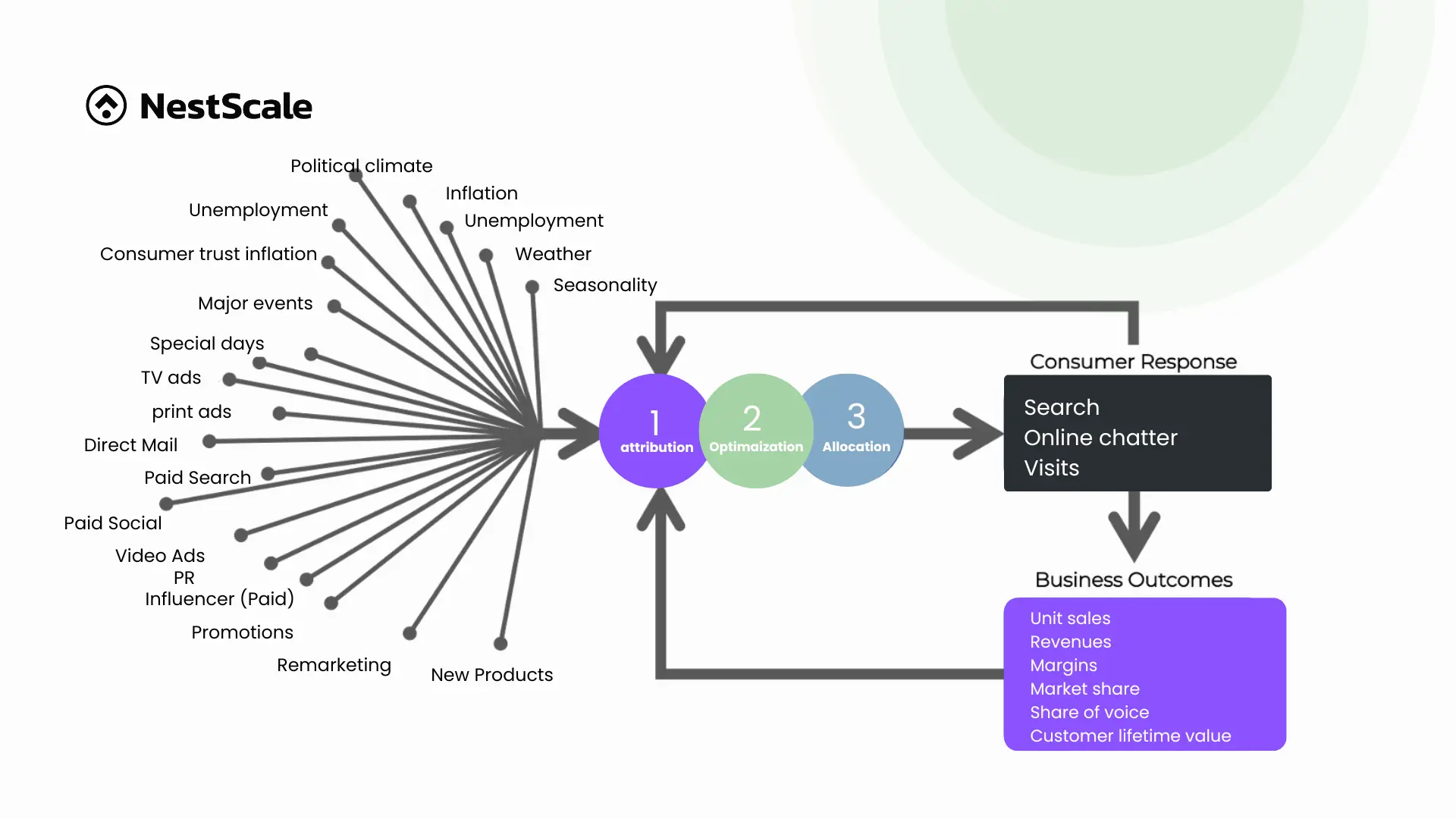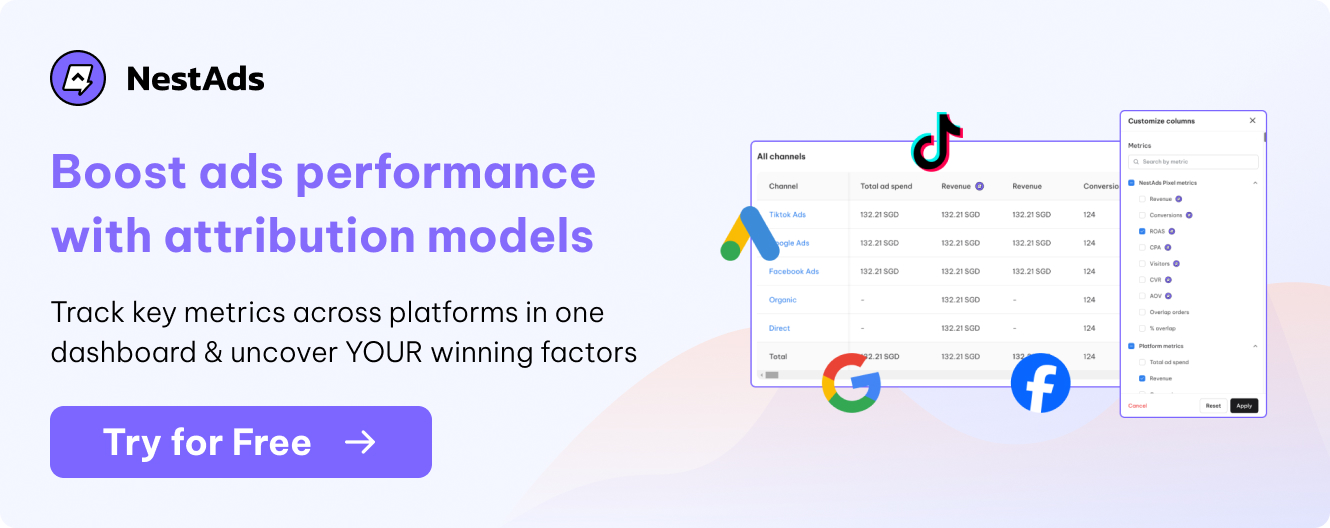Cross-channel attribution is crucial for understanding how your marketing efforts across different platforms contribute to sales. But with so many campaigns and channels in play, it can be tricky to pinpoint what’s really working. By understanding how your customers interact with various channels throughout their purchasing journey, cross-channel marketing attribution allows you to make data-driven decisions that maximize your return on ad spend (ROAS).
This guide explores the fundamentals of cross-channel attribution, its importance for growing businesses, and the most effective multi-channel attribution models. So, without any further ado, let’s dive in!
What is Cross Channel Attribution?
Cross-channel attribution is the process of analyzing the effects of different marketing channels on your customer’s journey and their decision. For example, a customer may first come across your product in a TikTok ad, later interact with a Facebook ad to explore further, and finally search for your store on Google to complete their purchase.

Why is Cross-Channel Attribution crucial?
Running advertising campaigns across multiple platforms presents unique challenges, particularly when it comes to tracking performance and allocating budgets effectively. Many merchants struggle with fragmented data, which makes it difficult to evaluate the collective performance of their marketing efforts. This often leads to budget inefficiencies, with overspending on underperforming channels and underinvesting in high-performing ones.
Cross-channel attribution addresses these challenges by consolidating data from all platforms, providing an understanding of how different channels work together. This approach enables merchants to allocate their budgets more effectively, optimize their campaigns, and focus on the strategies that deliver the best results.
Types of cross-channel attribution methods
Understanding cross-channel attribution models is essential for merchants looking to optimize their marketing strategies across multiple platforms. These models provide insights into how various touchpoints contribute to sales, allowing for data-driven decisions and more effective budget allocation. In this section, we explore three commonly used models including Multi-Touch Attribution, Media Mix Modeling, and Incrementality Measurement with practical examples to demonstrate their applications and advantages.
Multi-touch attribution (MTA)
Multi-touch attribution (MTA) is one of the most widely used models. This approach assigns credit to every touchpoint a customer interacts with before making a purchase, providing a more balanced view of how your channels contribute to conversions.
For instance, consider a customer’s journey where they first see your ad on TikTok, later click an ad on Facebook, and finally search for your store on Google to make a purchase. With MTA, partial credit is assigned to TikTok, Facebook, and Google based on their roles in the journey.
| Strengths | Weaknesses |
| – Clearly identifies the impact of each customer touchpoint.- Provides detailed insights into consumer behavior. | – Requires detailed data, which can be complex and expensive.- May not be accurate with limited data. |
Media Mix Modeling (MMM)
Media Mix Modeling (MMM) is a comprehensive analysis method that helps you understand the impact of various marketing channels on overall performance. Unlike attribution models that focus on individual customer journeys, MMM takes a broader view, analyzing historical data to evaluate how all channels collectively influence brand awareness, sales, and other key metrics.
For instance, consider a business investing in multiple channels such as email marketing, social media campaigns, and print advertising. MMM uses historical data to assess the effectiveness of each channel. It might reveal that email marketing build long-term brand awareness, social media campaigns drive immediate conversions, and print advertising supports customer retention.

| Strengths | Weaknesses |
| – Analyzes the effectiveness of media channels on a broad scale.- Predicts long-term results. | – Lacks detailed data, relying on aggregate analysis.- Data updates are slow and not responsive. |
Incrementality measurement
Incrementality measurement offers a different perspective by focusing on the additional sales generated by a specific campaign or channel. This model is particularly effective for testing the true value of your campaigns.
For example, to assess TikTok ads, you can divide customers into two groups—one exposed to the ads and the other as a control group. By comparing sales, you can determine the incremental impact of the campaign.
By comparing the sales between the two groups, you can determine the incremental value your TikTok campaign brings. Incrementality is an excellent tool for merchants looking to refine their strategies and allocate budgets to the most impactful channels.
| Strengths | Weaknesses |
| – Measures the actual impact of campaigns by comparing test and control groups.- Accurate in measuring specific impacts. | – Requires test and control groups, which can be time-consuming and costly.- Not suitable for all campaign types. |

How can you do cross-channel attribution?
Getting started with cross-channel attribution requires careful planning and the right tools to track and understand your customer journey. With a few straightforward steps, you can create a system that helps you measure the impact of your marketing efforts across multiple platforms.
Start tracking everything
The foundation of cross-channel attribution is robust tracking. Monitor all possible actions users take on your website, such as clicks, scrolls, video views, sign-ups, and purchases. These actions, often referred to as events, provide valuable insights into how customers interact with your brand. You can start tracking by following these steps:
- Add UTM parameters: Tag all your marketing URLs with UTM codes to identify traffic sources, campaigns, and specific content.
- Set up tracking pixel: Install tracking pixels (like Facebook Pixel, TikTok Pixel, or Google Analytics tags) on your website to capture events such as page views, clicks, and purchases.
- Define key events: Determine which actions matter most to your business, such as email sign-ups, add-to-cart actions, or checkout completions, and mark them as conversions.
- Use Server-side tracking: Complement client-side tracking with server-side methods to improve data accuracy and handle scenarios where cookies might not work.
Centralize your data
Data scattered across platforms can make cross-channel attribution messy and unreliable. Each platform has its own reporting system and metrics, making it difficult to compare results or get a full picture of performance. To overcome this, gather all your marketing data in one place. Centralized data eliminates inconsistencies and makes it easier to evaluate the contributions of each channel to your overall success.

Integrate with other tools
Tools like NestAds make cross-channel attribution more accessible by centralizing ad data from platforms like Facebook, TikTok, and Google. With NestAds, you can easily visualize your marketing performance, adjust attribution models to suit your strategy, and make data-driven decisions that grow your business. While no system can perfectly account for every offline or untracked interaction, using a reliable tool helps you move closer to an accurate understanding of your marketing impact.
How do you choose the right cross-channel attribution model?
Choosing the best attribution methods depends on your business goals, available data, and budget. Multi-touch attribution is ideal for businesses seeking a straightforward and actionable approach to analyzing customer journeys. Media Mix Modeling works well for merchants with complex marketing strategies that span both online and offline channels, but it requires extensive data and resources. Incrementality measurement is a great option for merchants focused on testing specific campaigns and making tactical adjustments.
NestAds simplifies the process of experimenting with different attribution models. Its intuitive platform allows merchants to centralize data, visualize customer journeys, and track performance metrics across all channels, making it easier to choose the model that fits your needs.




















































